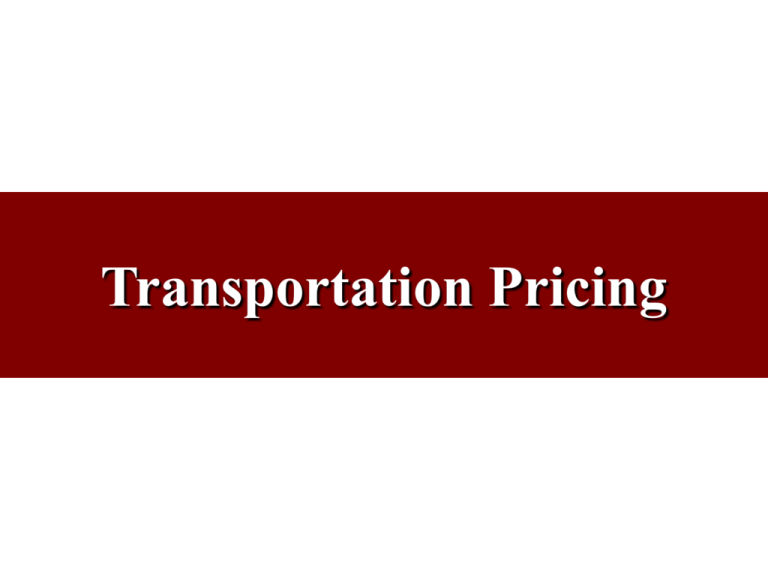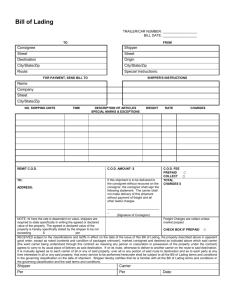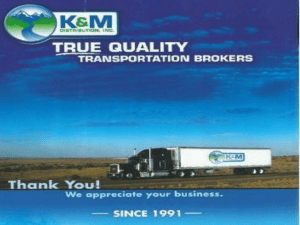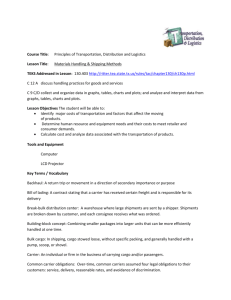Costing & Pricing in Transportation
advertisement

Transportation Pricing Character-of-Shipment Rates • Special rates related to the size or character of the shipment • Carriers generally have certain fixed costs for each shipment • Includes: – – – – – – – LTL/TL Rates Multiple-car Rates Incentive Rates Unit-train Rates Per-car & Per-truckload Rates Any-quantity Rates Density Rates Character-of-Shipment Rates • LTL/TL Rates – LTL shipments require multiple handlings – Each handling requires dock personnel, materialshandling equipment, terminal investment & additional communications/tracking efforts – Thus, higher rates for LTL shipments – TL shipments are generally loaded by the shipper, moved intact to destination, & unloaded by consignee. – No intermediate handlings required – No intermediate terminals required – Thus, lower rates for TL shipments Character-of-Shipment Rates • Multiple-car Rates – Railroad special rate – Volume discount for moves of more than one carload that are shipped as a single string of cars from one point to another – Cost of moving multiple cars in single shipment proportionally less than cost of each car moved singly – Multiple cars can be handled by same effort as a single-car shipment • • • • Empty car drop-off Pickup Delivery efforts Documentation – Only basic difference is the additional weight moved Character-of-Shipment Rates • Incentive Rates – Rate designed to induce shipper to load existing movements and equipment more fully – Usually apply only to weight or units loaded over and above normally shipped quantities – Fewer cars and moves are required over the course of a year, though same actual volume is shipped – Example • Appliance manufacturer typically ships carload quantities that only fill car to 80% of capacity • Minimum carload rate is 40,000 lbs; capacity 60,000 lbs • Manufacturer normally only loads 48,000 lbs. • Incentive rate would apply to the additional 12,000 lbs. Character-of-Shipment Rates • Unit-train Rates – Integrated movements between an origin & destination – Trains usually avoid terminals & do not require intermediate switching or handling of individual cars – Shipper or consignee typically provides the railcars Character-of-Shipment Rates • Per-car & Per-truckload rates – Single-charge rates for specific origin-destination moves regardless of shipment commodity or weight – Also apply to container movements where carriers’ costs of movement dominated by moving the equipment & not specifically by shipment weight Character-of-Shipment Rates • Any-quantity Rates – AQ rates provide no discount or rate-break for larger movements • LTL rates exist but no TL rates for large shipments – Apply to any weight in a shipment – Usually used for shipment of large, bulky commodities such as boats, suitcases, and cages where no economies are realized by the carrier for larger shipments Character-of-Shipment Rates • Density Rates – Rates published by density of the shipment and its weight, not by commodity or weight alone – Common in air carrier shipments – Applied when carrier assesses rates on basis of weight, but does not experience fewer costs for lighter-weight containers Area, Location, or Route Rates • Includes: – – – – – – – Local rates Joint rates Proportional rates Differential rates Per-mile rates Terminal-to-Terminal rates Blanket or Group rates Area, Location, or Route Rates • Local Rates – Apply to any rate between 2 points served by the same carrier – Include full-cost factors for pickup, documentation, rating, billing, and delivery • Joint Rates – Single rates published from a point on one carrier’s route to another carrier’s destination – Usually lower in total charges than the combination of local rates Area, Location, or Route Rates • Proportional Rates – Some carriers at competitive disadvantage when they compete with other more direct lines – Carrier might publish a proportional or lower rate than its regular local rate that applies only to through moves to certain destination points beyond its line Area, Location, or Route Rates • Differential Rates – Published rate by a carrier that faces a service time disadvantage compared to a faster carrier or mode • Water carriers often publish differential rates lower than regular rates of railroads – Lower rate offsets somewhat the longer transit time disadvantage Area, Location, or Route Rates • Per-mile Rates – Rates based purely upon the mileage involved – Generally used in situations in which weight of shipment of lower significance • Terminal-to-Terminal Rates – Ramp-to-ramp rates that require shipper and consignee to perform the traditional pickup and delivery functions Area, Location, or Route Rates • Blanket or Group Rates – Apply to or from whole regions rather than points – All shipments coming from (going to) a region are treated as coming from (going to) the same point of origin (destination) – Example • All lumber shipments from Oregon & Washington are treated as having the same origin • Food shipments from California & Florida treated similarly Time/Service Rates • Generally dependent on the transit time performance of the carrier in a particular service • Shipper pays a higher rate for faster service & lower rate for slower – Reduced rates offered for certain minimum tonnage shipped over a specified period – Deferred delivery contracts in which carrier charges lower rate for privilege of deferring arrival time of shipment • Air expresses companies offer 25% discount or more for second- or third-day delivery as opposed to next-day delivery • Gives carrier more operating flexibility Other Rate Structures • Corporate Volume Rates – Discounted rate for each LTL shipment that is related to the total volume of LTL shipments that a firm ships via a specific carrier from all shipping points – More volume shipper tenders to a particular carrier, the greater the discount – Not widely used today Other Rate Structures • Discounts – LTL shipments of a specific commodity class moving between given origins and destinations • Loading Allowances – Reduced rate or discount granted if shipper loads LTL shipments into carrier’s vehicle • Aggregate Tender Rates – Reduced rate or discount granted if shipper tenders 2 or more class-rated shipments to the carrier at one time – Aggregate usually must equal 5000 lbs minimum – Tender of 2 or more reduces number of times carrier goes to shipper’s facility to pickup cargo Other Rate Structures • FAK Rates – All-commodity rates expressed in cents per hundredweight or total cost per shipment – Rate based on cost of service, not the commodity hauled – Involves mixed commodities shipments – Generally used in shipment of groceries Other Rate Structures • Empty-haul Rates – Charge for moving empty rail or motor equipment that is owned or leased by or assigned to a particular shipper – Induces shipper to fully load all miles of the equipment movements • 2-way or 3-way Rates – Apply to rates that are constructed and charged when backhaul or triangular moves can be made – Intent is to tie a fronthaul move with what would have been another firm’s backhaul. Other Rate Structures • Spot-Market Rates – Special rate offered to facilitate movement of equipment or product – Generally used if excess supply of empty trailers begins accumulating in a geographic region • Menu Pricing – Allows a shipper to pick and choose those services the carrier should perform – Requires the carrier to understand and know its costs of providing various services on the “menu.”






